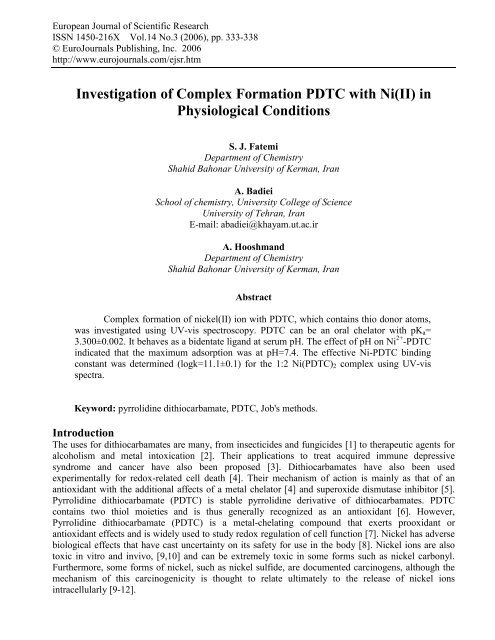European Journal of Scientific Research - EuroJournals
European Journal of Scientific Research - EuroJournals
European Journal of Scientific Research - EuroJournals
Create successful ePaper yourself
Turn your PDF publications into a flip-book with our unique Google optimized e-Paper software.
<strong>European</strong> <strong>Journal</strong> <strong>of</strong> <strong>Scientific</strong> <strong>Research</strong><br />
ISSN 1450-216X Vol.14 No.3 (2006), pp. 333-338<br />
© Euro<strong>Journal</strong>s Publishing, Inc. 2006<br />
http://www.eurojournals.com/ejsr.htm<br />
Investigation <strong>of</strong> Complex Formation PDTC with Ni(II) in<br />
Physiological Conditions<br />
S. J. Fatemi<br />
Department <strong>of</strong> Chemistry<br />
Shahid Bahonar University <strong>of</strong> Kerman, Iran<br />
A. Badiei<br />
School <strong>of</strong> chemistry, University College <strong>of</strong> Science<br />
University <strong>of</strong> Tehran, Iran<br />
E-mail: abadiei@khayam.ut.ac.ir<br />
A. Hooshmand<br />
Department <strong>of</strong> Chemistry<br />
Shahid Bahonar University <strong>of</strong> Kerman, Iran<br />
Abstract<br />
Complex formation <strong>of</strong> nickel(II) ion with PDTC, which contains thio donor atoms,<br />
was investigated using UV-vis spectroscopy. PDTC can be an oral chelator with pKa=<br />
3.300±0.002. It behaves as a bidentate ligand at serum pH. The effect <strong>of</strong> pH on Ni 2+ -PDTC<br />
indicated that the maximum adsorption was at pH=7.4. The effective Ni-PDTC binding<br />
constant was determined (logk=11.1±0.1) for the 1:2 Ni(PDTC)2 complex using UV-vis<br />
spectra.<br />
Keyword: pyrrolidine dithiocarbamate, PDTC, Job's methods.<br />
Introduction<br />
The uses for dithiocarbamates are many, from insecticides and fungicides [1] to therapeutic agents for<br />
alcoholism and metal intoxication [2]. Their applications to treat acquired immune depressive<br />
syndrome and cancer have also been proposed [3]. Dithiocarbamates have also been used<br />
experimentally for redox-related cell death [4]. Their mechanism <strong>of</strong> action is mainly as that <strong>of</strong> an<br />
antioxidant with the additional affects <strong>of</strong> a metal chelator [4] and superoxide dismutase inhibitor [5].<br />
Pyrrolidine dithiocarbamate (PDTC) is stable pyrrolidine derivative <strong>of</strong> dithiocarbamates. PDTC<br />
contains two thiol moieties and is thus generally recognized as an antioxidant [6]. However,<br />
Pyrrolidine dithiocarbamate (PDTC) is a metal-chelating compound that exerts prooxidant or<br />
antioxidant effects and is widely used to study redox regulation <strong>of</strong> cell function [7]. Nickel has adverse<br />
biological effects that have cast uncertainty on its safety for use in the body [8]. Nickel ions are also<br />
toxic in vitro and invivo, [9,10] and can be extremely toxic in some forms such as nickel carbonyl.<br />
Furthermore, some forms <strong>of</strong> nickel, such as nickel sulfide, are documented carcinogens, although the<br />
mechanism <strong>of</strong> this carcinogenicity is thought to relate ultimately to the release <strong>of</strong> nickel ions<br />
intracellularly [9-12].

















